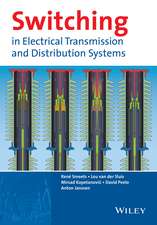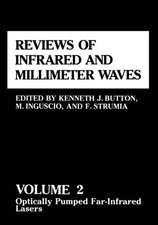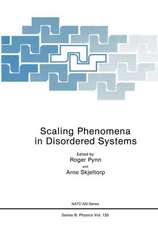Digital Transmission Systems
Autor David R. Smithen Limba Engleză Paperback – 8 noi 2012
| Toate formatele și edițiile | Preț | Express |
|---|---|---|
| Paperback (2) | 659.02 lei 43-57 zile | |
| Springer Us – 6 iun 2013 | 659.02 lei 43-57 zile | |
| Springer Us – 8 noi 2012 | 836.45 lei 38-44 zile | |
| Hardback (2) | 1244.59 lei 43-57 zile | |
| Springer Us – 27 feb 1993 | 1244.59 lei 43-57 zile | |
| Springer Us – 30 noi 2003 | 1418.52 lei 43-57 zile |
Preț: 836.45 lei
Preț vechi: 1100.59 lei
-24% Nou
Puncte Express: 1255
Preț estimativ în valută:
160.11€ • 173.97$ • 134.58£
160.11€ • 173.97$ • 134.58£
Carte tipărită la comandă
Livrare economică 16-22 aprilie
Preluare comenzi: 021 569.72.76
Specificații
ISBN-13: 9781461347262
ISBN-10: 1461347262
Pagini: 852
Ilustrații: XVII, 808 p.
Dimensiuni: 155 x 235 x 45 mm
Greutate: 1.3 kg
Ediția:3rd ed. 2004. Softcover reprint of the original 3rd ed. 2004
Editura: Springer Us
Colecția Springer
Locul publicării:New York, NY, United States
ISBN-10: 1461347262
Pagini: 852
Ilustrații: XVII, 808 p.
Dimensiuni: 155 x 235 x 45 mm
Greutate: 1.3 kg
Ediția:3rd ed. 2004. Softcover reprint of the original 3rd ed. 2004
Editura: Springer Us
Colecția Springer
Locul publicării:New York, NY, United States
Public țintă
Professional/practitionerDescriere
Digital Transmission Systems, Third Edition, is a comprehensive overview of the theory and practices of digital transmission systems used in digital communication. This new edition has been completely updated to include the latest technologies and newest techniques in the transmission of digitized information as well as coverage of digital transmission design, implementation and testing.
Highlights of this edition: -New material on error correction codes, multiple access, digital modulation, digital subscriber lines, cable modems, mobile wireless, wide area networks, and optical networks;
-Up-to-date industry standards and practices - including voice/video coding, digital subscriber lines, SONET/SDH, DWDM, ATM, broadband wireless access, network synchronization, and network management - are described and interpreted;
-Expanded problem sets (totaling over 300) at the end of each chapter for review and practice;
-All chapters have been updated with particular emphasis given to fiber optics, wireless and networks.
The book is heavily illustrated with tables, figures and an abundance of examples and references to actual systems. Examples are from common carriers, manufacturers and the author's commercial experience. Telecommunications terms are defined and explained when first introduced.
Practicing engineers in the field of communication systems, managers and technical personnel in the IT industry, and students of electrical and communications engineering will find this an authoritative state-of-the-art resource.
Highlights of this edition: -New material on error correction codes, multiple access, digital modulation, digital subscriber lines, cable modems, mobile wireless, wide area networks, and optical networks;
-Up-to-date industry standards and practices - including voice/video coding, digital subscriber lines, SONET/SDH, DWDM, ATM, broadband wireless access, network synchronization, and network management - are described and interpreted;
-Expanded problem sets (totaling over 300) at the end of each chapter for review and practice;
-All chapters have been updated with particular emphasis given to fiber optics, wireless and networks.
The book is heavily illustrated with tables, figures and an abundance of examples and references to actual systems. Examples are from common carriers, manufacturers and the author's commercial experience. Telecommunications terms are defined and explained when first introduced.
Practicing engineers in the field of communication systems, managers and technical personnel in the IT industry, and students of electrical and communications engineering will find this an authoritative state-of-the-art resource.
Cuprins
Preface. Acknowledgement. 1: Introduction to Digital Transmission Systems. 1.1. Historical Background. 1.2. Present-Day Digital Transmission. 1.3. Digital Transmission Standards. 1.4. Advantages of Digital Transmission. 1.5. A Simplified Digital Transmission System. 1.6. Summary. 2: Principles of System Design. 2.1. General Plan. 2.2. Transmission Services. 2.3. Hypothetical Reference Circuits. 2.4. Performance Objectives. 2.5. Summary. Problems. 3: Analog-to-Digital Conversion Techniques. 3.1. Introduction. 3.2. Pulse Code Modulation. 3.3. Differential PCM and Delta Modulation. 3.4. Adaptive Differential Pulse Code Modulation. 3.5. Subband Coding. 3.6. Transform Coding. 3.7. Comparison of Waveform Coders. 3.8. Voice Coders (Vocoders). 3.9. Hybrid Coders. 3.10. Video Coders. 3.11. Summary. Problems. 4: Time-Division Multiplexing. 4.1. Introduction. 4.2. Synchronous Multiplexing. 4.3. Asynchronous Multiplexing. 4.4. Digital Multiplex Hierarchies. 4.5. Statistical Multiplexing and Speech Interpolation. 4.6. Summary. Problems. 5: Baseband Transmission. 5.1. Introduction. 5.2. Types of Binary Coding. 5.3. Power Spectral Density of Binary Codes. 5.4. Error Performance of Binary Codes. 5.5. Block Line Codes. 5.6. Pulse Shaping and Intersymbol Interference. 5.7. Multilevel Baseband Transmission. 5.8. Partial Response Coding. 5.9. Eye Patterns. 5.10. Equalization. 5.11. Data Scrambling Techniques. 5.12. Spread Spectrum. 5.13. Access Techniques. 5.14. Error Detection and Correction Coding. 5.15. Summary. Problems. 6: Digital Modulation Techniques. 6.1. Introduction. 6.2. Binary Amplitude-Shift Keying (ASK). 6.3. Binary Frequency-Shift Keying (FSK). 6.4. Binary Phase-Shift Keying (PSK). 6.5. Comparison of Binary Modulation Systems. 6.6. M-ary FSK. 6.7. M-ary PSK. 6.8. Quadrature Amplitude Modulation (QAM). 6.9. Offset QPSK (OQPSK) and Minimum-Shift Keying (MSK). 6.10. Quadrature Partial Response (QPR). 6.11. Trellis Coded Modulation. 6.12. Orthogonal Frequency Division Multiplexing. 6.13. Summary. Problems. 7: Digital Cable Systems. 7.1. Introduction. 7.2. Cable Characteristics. 7.3. Regenerative Repeaters. 7.4. Clock Recovery and Jitter. 7.5. Crosstalk. 7.6. Error Performance for Tandem Repeaters. 7.7. Repeater Spacing for Multipair Cable Systems. 7.8. Repeater Spacing for Coaxial Cable Systems. 7.9. Implementation Considerations. 7.10. Summary. 7.11. Problems. 8: Fiber Optic Transmission Systems. 8.1. Introduction. 8.2. Fiber Optic Cable. 8.3. Optical Sources. 8.4. Optical Detectors. 8.5. Optical Amplifiers. 8.6. Optical Multiplexing. 8.7. Repeater Spacing in Fiber Optic Systems. 8.
Caracteristici
Is heavily illustrated with tables, figures and an abundance of examples and references to actual systems
Request lecturer material: sn.pub/lecturer-material
Request lecturer material: sn.pub/lecturer-material




















